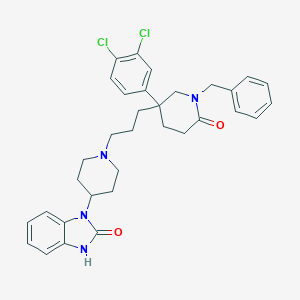

You can:
| Name | CHEMBL26790 |
|---|---|
| Molecular formula | C33H36Cl2N4O2 |
| IUPAC name | 3-[1-[3-[1-benzyl-3-(3,4-dichlorophenyl)-6-oxopiperidin-3-yl]propyl]piperidin-4-yl]-1H-benzimidazol-2-one |
| Molecular weight | 591.577 |
| Hydrogen bond acceptor | 3 |
| Hydrogen bond donor | 1 |
| XlogP | 6.1 |
| Synonyms | 1-(1-{3-[1-Benzyl-3-(3,4-dichloro-phenyl)-6-oxo-piperidin-3-yl]-propyl}-piperidin-4-yl)-1,3-dihydro-benzoimidazol-2-one BDBM50070353 SCHEMBL7842031 |
| Inchi Key | ADXFJIYJEFFOSY-UHFFFAOYSA-N |
| Inchi ID | InChI=1S/C33H36Cl2N4O2/c34-27-12-11-25(21-28(27)35)33(17-13-31(40)38(23-33)22-24-7-2-1-3-8-24)16-6-18-37-19-14-26(15-20-37)39-30-10-5-4-9-29(30)36-32(39)41/h1-5,7-12,21,26H,6,13-20,22-23H2,(H,36,41) |
| PubChem CID | 23294208 |
| ChEMBL | CHEMBL26790 |
| IUPHAR | N/A |
| BindingDB | 50070353 |
| DrugBank | N/A |
Structure |  |
| Lipinski's druglikeness | This ligand is heavier than 500 daltons. This ligand has a partition coefficient log P greater than 5. |
You can:
| GLASS ID | Name | UniProt | Gene | Species | Length |
|---|---|---|---|---|---|
| 3202 | C-C chemokine receptor type 5 | P51681 | CCR5 | Homo sapiens (Human) | 352 |
| 3201 | Neuromedin-K receptor | P29371 | TACR3 | Homo sapiens (Human) | 465 |
| 3199 | Substance-K receptor | P21452 | TACR2 | Homo sapiens (Human) | 398 |
| 3200 | Substance-P receptor | P25103 | TACR1 | Homo sapiens (Human) | 407 |
zhanglab![]() zhanggroup.org | +65-6601-1241 | Computing 1, 13 Computing Drive, Singapore 117417
zhanggroup.org | +65-6601-1241 | Computing 1, 13 Computing Drive, Singapore 117417